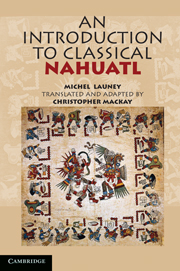Book contents
- Frontmatter
- Contents
- Preface
- How to Use This Book
- PART ONE
- PART TWO
- Lesson Sixteen Agent Nouns, the -ni Form
- Lesson Seventeen Compound Nouns, Verbal Incorporation
- Lesson Eighteen Bitransitive Verbs, Ambitransitive Verbs
- Lesson Nineteen Causative Verbs
- Lesson Twenty Applicative Verbs
- Lesson Twenty-One Honorific and Deprecatory Verbs
- Lesson Twenty-Two Pluperfect, Counterfactual, Vetitive, Directional Conjugations
- Lesson Twenty-Three Morphological Peculiarities of Certain Nouns and Verbs
- Lesson Twenty-Four More on Locatives
- Lesson Twenty-Five More on Quantifiers
- Lesson Twenty-Six Details about Number and Person, Indefinite Pronouns and Adverbs
- Lesson Twenty-Seven Compound Verbs
- Lesson Twenty-Eight Reduplication outside of the Plural, More on Verbs
- Lesson Twenty-Nine Derivative Verbs
- Lesson Thirty Derivative Nouns
- Lesson Thirty-One Noun Clauses
- Lesson Thirty-Two Attributives, Relative Clauses, Copula Verbs, Semi-Auxiliaries
- Lesson Thirty-Three Comparisons, Clauses of Result, Purpose and Cause
- Lesson Thirty-Four Conditions, More Particles
- Lesson Thirty-Five Temporal Clauses, Particles, Interjections
- Appendix One Traditional Orthography
- Appendix Two The Aztec Calendar
- Appendix Three Inflexional Patterns
- Appendix Four Key to the Exercises
- Nahuatl-to-English Vocabulary
- English-to-Nahuatl Vocabulary
- Index
Lesson Thirty-Two - Attributives, Relative Clauses, Copula Verbs, Semi-Auxiliaries
Published online by Cambridge University Press: 05 June 2012
- Frontmatter
- Contents
- Preface
- How to Use This Book
- PART ONE
- PART TWO
- Lesson Sixteen Agent Nouns, the -ni Form
- Lesson Seventeen Compound Nouns, Verbal Incorporation
- Lesson Eighteen Bitransitive Verbs, Ambitransitive Verbs
- Lesson Nineteen Causative Verbs
- Lesson Twenty Applicative Verbs
- Lesson Twenty-One Honorific and Deprecatory Verbs
- Lesson Twenty-Two Pluperfect, Counterfactual, Vetitive, Directional Conjugations
- Lesson Twenty-Three Morphological Peculiarities of Certain Nouns and Verbs
- Lesson Twenty-Four More on Locatives
- Lesson Twenty-Five More on Quantifiers
- Lesson Twenty-Six Details about Number and Person, Indefinite Pronouns and Adverbs
- Lesson Twenty-Seven Compound Verbs
- Lesson Twenty-Eight Reduplication outside of the Plural, More on Verbs
- Lesson Twenty-Nine Derivative Verbs
- Lesson Thirty Derivative Nouns
- Lesson Thirty-One Noun Clauses
- Lesson Thirty-Two Attributives, Relative Clauses, Copula Verbs, Semi-Auxiliaries
- Lesson Thirty-Three Comparisons, Clauses of Result, Purpose and Cause
- Lesson Thirty-Four Conditions, More Particles
- Lesson Thirty-Five Temporal Clauses, Particles, Interjections
- Appendix One Traditional Orthography
- Appendix Two The Aztec Calendar
- Appendix Three Inflexional Patterns
- Appendix Four Key to the Exercises
- Nahuatl-to-English Vocabulary
- English-to-Nahuatl Vocabulary
- Index
Summary
Attributives
We have already had occasion to see (Lesson 12) that in Nahuatl there are not any adjectives properly speaking, just nouns derived from verb forms that tend to be translated by adjectives in languages such as English. Conversely, the capacity to modify nouns does not constitute a specific category of words in Nahuatl, because a noun can be modified by an “adjective,” another noun, a locative, or (as we will see later) any verbal form. In English, an adjective that directly modifies a noun is placed in front of it (e.g., ‘the big dog…’). We will call any Nahuatl form that modifies a noun in this way an attributive. Here we will deal with nouns with an adjectival sense in English (12.2), quasi-adjectives derived from verbs (12.4–6), possessive nouns (11.7), and locatives used adjectivally.
The attributive can precede or follow its noun. The order is (determiner)-attributive-noun or (determiner)-noun-attributive (“determiner” means a form like in or inin, inon, or cē, ōme, miyac etc.). This order is obviously much freer than in English; it is difficult to give general principles for the placement of attributives, and the most that can be said is that the following forms always appear before their noun:
cualli, yēctli ‘good’: cualli tlācatl ‘good person’
quantifiers, including huēyi
huēhuê ‘old’: in huēhuê Motēuczōma ‘Moctezuma the Elder’
locatives: in Caxtillān tlaīlli ‘wine (drink from Castile)’, in huècapan tlālli ‘the high country, uplands’; in nechca tetl ‘the stone (located) there’; in ilhuicac āhuiyacāyōtl ‘the fragrance in heaven, heavenly fragrance’
- Type
- Chapter
- Information
- An Introduction to Classical Nahuatl , pp. 328 - 339Publisher: Cambridge University PressPrint publication year: 2011

